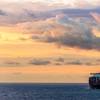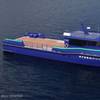Risk Management
Running a Tight Ship
The old expression about getting one’s sea legs speaks to how different life can be in the ocean marine environment. Those who spend most of their time on land often need to adjust to the rhythms that are second nature to old sea hands.
Similarly, any company that operates both on land and water needs to adjust its risk management strategies to account for exposures in both arenas. That can range from something as simple as making sure land-based workers have the right protective equipment when they move to the waterfront, to something as complex as coordinating insurance coverage to minimize the possibility of gaps or unexpected liabilities.
By working with a knowledgeable insurance agent or broker who has experience in ocean marine exposures, companies can identify the insurance products they need and develop strong risk control practices to help keep their employees safe and their claims record clean.
Expecting the Unexpected
A marine business, whether it is a vessel operator, ship repairer or construction contractor, may have significant assets that are land-based. The company’s headquarters may have employees who work at desks, or drive cars to pick up supplies, or travel to conferences to develop new business leads. Other employees may divide their time between land, waterfront and vessels. As they move back and forth, their exposure to risk and the potential liabilities for their employer can change dramatically. Companies that carry only standard property and casualty insurance may find they are facing gaps in coverage when their business operations move into the maritime world.
For example, most companies expect their state-regulated workers compensation insurance to cover employees who are injured on the job. However, if the employee is on a vessel, he or she may instead fall under the federal Jones Act, which governs the remedies for sailors who are injured. And if the employee is working dockside when an accident occurs, he or she may be subject to a different federal act, the Longshore and Harbor Workers Compensation Act, which addresses injuries on navigable waters and adjoining areas. As a result, a company with only traditional workers compensation coverage may find itself exposed to unexpected liability as their employees take on different roles. Another issue is liability for what insurers call “care, custody and control” – for example, when someone has taken charge of a third party’s property that subsequently becomes damaged. A traditional general liability policy may exclude coverage for care, custody and control situations, which may in turn cause a contractor to arrange for special coverage to manage those types of risks. However, the additional coverage may apply only to land-based scenarios, leaving the contractor unexpectedly exposed when a job takes him to a ship or a dock. Because of different standards, regulations and laws, it is critical that businesses straddling the line between land and ocean marine environments have coverage that is well-coordinated for their full range of exposures. Insurance agents who are experienced in ocean marine risks and understand ocean marine products are in the best position to identify potential gaps in coverage.
Making Safety a Priority
Having the right insurance in place is important, but just as critical is creating a culture of safety that carries through with employees whether they are working on land or water. The commitment to safe practices has to begin at the top with strong policies about safety training, equipment maintenance, proper procedures and well-delineated accountability. However, employees at every level, from managers and supervisors to front-line employees, have a role to play in managing risk.
• A culture of safety and emphasis on training.
Taking job-site safety seriously makes sense for any business. In addition to the human costs, accidents and injuries disrupt work, delay projects and divert resources. When a company has workers that shift between land and water as they perform their tasks, it is even more critical to focus on proper training and adequate safety precautions. Companies that have vigilant safety policies and cultures clearly benefit and tend to attract top-notch employees.
• Provide and enforce the proper use of Personal Safety Equipment
A welder who is perfectly comfortable putting his skill to work on land may need to be reminded of special safety precautions if his project is on a barge. A flotation vest is not necessary for a welder at a workshop, but it may make the difference between drowning and surviving if the welder is knocked overboard wearing heavy boots and thick protective clothing. Along with personal responsibility, site managers must be vigilant and consistent in enforcing the use of safety equipment along with ensuring it is in good condition.
• Be sure your operation is accountingfor the unique characteristics of the marine environment
For example, crane operators can encounter problems with docks or unstable soil that cannot support the weight of the crane while working ashore. Likewise, when working from a floating platform, ensuring that crane operators understand the additional effects of a floating platform upon the crane’s limitation is critical.
Another example is when workers who are experienced in pouring concrete on land are faced with different conditions and safety factors when the project is a bridge footing. They may find themselves coping with unfamiliar soil conditions and working inside a cofferdam that is holding water at bay. In all of these situations and many more, the site supervisor plays a pivotal role in addressing safety. He is in a position to make the critical decisions each day about when it is safe to proceed; what equipment and safety measures need to be deployed; and which members of the team should take on each task. When a supervisor’s commitment to safety is clear to every team member, workers can focus on being more productive because they have confidence they are working in a safe environment.
The Buck Stops Here
The attitude toward safety at the home office and the vigilance of the site supervisor are both important, but in the end, safety is also the personal responsibility of every worker. Employees must not only follow proper procedures, but also be alert to danger as it develops. When a business has created a culture that emphasizes safety, employees know they can speak up about unsafe conditions without fear of retaliation. They can feel comfortable about making suggestions for improving processes, and are much more likely to learn from each other’s mistakes and near-misses.
Creating a culture that encourages and celebrates safe practices is not a one-and-done task. As companies seek to complete jobs and minimize overhead, safety can drop to the bottom of the priority list. To keep safe practices on everyone’s radar, companies can work with their agents and brokers to tap into the expertise that their insurance company offers through risk management services.
Because insurance companies are in a position to know about both the safety procedures and accidents at a wide variety of businesses, their risk management specialists understand from a practical perspective what works well and what falls short of effectiveness. By analyzing a company’s current safety strengths and weaknesses, risk management specialists can identify key best practices than can make a difference, helping a company safeguard employees and minimize costly accidents.
Making safety a priority and having the right insurance coverage when something goes wrong should be standard operating procedures for every business. When it comes to companies that move between land and water, however, it is important to understand how exposures and potential liabilities change. By working with experienced agents, brokers and insurance companies, a maritime business can gain the ability to run a tight ship when it comes to risk management.
Kirk Rider,
Ocean Marine Director, Risk ControL, Travelers
(As published in the March 2013 edition of Maritime Reporter & Engineering News - www.marinelink.com)













